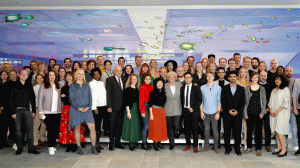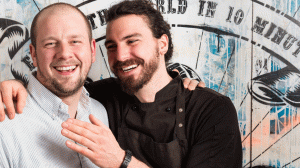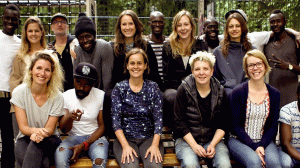Effective Altruism — what exactly is it?
Effective Altruism is a growing social movement that taps into both the heart and the head. It's about uniting compassion and reason to answer the question, "Of all the possible ways to make a difference, how can I make the greatest difference?” Where can I invest my time and resources to achieve the greatest possible impact?
In this article, which was originally published here, Ben Kuhn gives an overview of relevant reading materials to help busy people pursue their path to effective altruism.
1. Introductory materials
Start with one (not all) of these three articles for a good overview of what it means to think like an effective altruist—mainly about treating all lives equally, and trying to do what helps the most (rather than just something that helps).
-
Efficient Charity: Do Unto Others is a fantastic primer on basic EA ideas by a really awesome writer. This is the essay that got me seriously thinking about effective altruism (1,800 words):
Imagine you are setting out on a dangerous expedition through the Arctic on a limited budget. The grizzled old prospector at the general store shakes his head sadly: you can’t afford everything you need; you’ll just have to purchase the bare essentials and hope you get lucky. But what is essential? Should you buy the warmest parka, if it means you can’t afford a sleeping bag? Should you bring an extra week’s food, just in case, even if it means going without a rifle? Or can you buy the rifle, leave the food, and hunt for your dinner?
- If you prefer videos, Peter Singer’s TED talk is another canonical introduction to EA (17 minutes):
I wonder how many of you, looking at [footage of a toddler being run over], said to yourselves just now, “I would not have done that. I would have stopped to help.” Raise your hands if that thought occurred to you.
As I thought, that’s most of you. And I believe you. I’m sure you’re right. But before you give yourself too much credit, look at this. UNICEF reports that in 2011, 6.9 million children under five died from preventable, poverty-related diseases. UNICEF thinks that that’s good news because the figure has been steadily coming down from 12 million in 1990. That is good. But still, 6.9 million is 19,000 children dying every day. Does it really matter that we’re not walking past them in the street? Does it really matter that they’re far away? I donp’t think it does make a morally relevant difference. The fact that they’re not right in front of us, the fact, of course, that they’re of a different nationality or race, none of that seems morally relevant to me. What is really important is, can we reduce that death toll? Can we save some of those 19,000 children dying every day?
- Wikipedia also has a good general overview, albeit drier than the previous two. The first sentence includes my favorite one-sentence description of effective altruism (2,300 words):
Effective altruism is a philosophy and social movement which applies evidence and reason to working out the most effective ways to improve the world. Effective altruists consider all causes and actions, and then act in the way that brings about the greatest positive impact. It is this broad evidence-based approach that distinguishes effective altruism from traditional altruism or charity. Effective altruism sometimes involves taking actions that are less intuitive or emotionally salient. The philosopher Peter Singer is a notable supporter of effective altruism.
2. On Your Personal Choices
If taken too extremely, effective altruism can seem incredibly demanding. How can we justify spending anything at all on ourselves when the money could objectively do much more good elsewhere? There’s no good canned answer to this question yet—everyone struggles with figuring out where to draw the line, or what standard to hold themselves to. But reading about other people’s personal strategies and takes on the question can be really informative.
- Julia Wise’s excellent essay Cheerfully discusses the author’s struggles with trading off her own welfare against others’. It lives up to the author’s name. Julia’s entire blog, Giving Gladly, is well worth reading on this topic (500 words):
When I was younger, I was extremely struck by the realization that my choice to donate or not meant the difference between someone else’s living and dying. A lot of decisions started to look very starkly wrong.
I remember telling my dad that I had decided it would be immoral for me to have children, because they would take too much of my time and money away from better causes. “It doesn’t sound like this lifestyle is going to make you happy,” he said.
“My happiness is not the point,” I told him.
- Jeff Kauffman (Julia’s husband) has also written about how he and Julia budget their money so that they don’t feel angst about every time they spend money on themselves. Jeff and Julia donate about 50% of their combined income, so they’ve figured out a lot about how to make giving work for them psychologically (500 words):
For me the key is to make most choices donation neutral. As money comes in I divide it into “money to give to the most effective charity” and “money to spend as I wish”. How to divide it is a hard and distressing choice, but it’s one I only have to make once a year. Then when deciding to buy something (socks, rent, phone, instruments, food) I know it’s money that isn’t getting given away regardless, so I don’t have to feel constantly guilty about making tradeoffs with people’s lives.
- Bernadette Young wrote an excellent piece on reconciling effective altruism with parenthood, one of the costliest personal decisions one can make. It’s a paradigm example of treating other such difficult decisions in the context of trying to live an effective life (3,000 words):
The choice to become a parent is one of the biggest and most binding life decisions we can make. How might that decision go if you want to incorporate principles of effective altruism in the big decisions of your life? In considering the costs and attractions of parenthood, I will make the case that having children can indeed be consistent with those principles. I’ll also explain why I think the EA movement should be open to the idea of parenthood as part of an EA life.
- Last December in giving season, GiveWell’s staff co-published a post on their personal donation plans. It’s very informative as an example of effective altruists’ thought processes (4,100 words):
Yet it wouldn’t feel right to skip giving to charity altogether (or to give to the organization that employs me). In general, I try to behave as I would like others to behave: I try to perform very well on “standard” generosity and ethics, and overlay my more personal, debatable, potentially-biased agenda on top of that rather than in replacement of it. I wouldn’t steal money to give it to our top charities; I wouldn’t skip an important family event (even one that had little meaning for me) in order to save time for GiveWell work; and along the same lines, I want to give some substantial portion of my money each year in a way that (a) aims at helping the less fortunate (b) can’t be confused with aiming to benefit myself or those in my circle. In addition, cutting a check for the sole purpose of helping others is something I want to stay practiced at.
3. On Thinking Like an Effective Altruist
In my view, there are four main principles of effective altruism:
-
Maximization: trying to do the most good rather than just some good (and accepting that different things do different amounts of good).
-
Cause-neutrality: being willing to consider any cause based on how effective it is, rather than giving based on pre-existing “passion” or “connection” to a cause.
-
Egalitarianism: valuing the well-being of all sentient beings equally.
-
Consequentialism: taking into account all the consequences of your actions, not just the direct consequences. For example, if you don’t take that job with a nonprofit, would they have just hired someone else instead?
Although these ideas seem intuitive and obvious, they’re hard to digest fully! So it helps to look at where other people have gone with them.
-
GiveWell has a list of charity evaluation questions that go really in-depth in their process. (hard to get a word count; just poke around and skim)
-
For an example application of GiveWell’s process, check out their report on GiveDirectly, their current top-rated charity. But probably don’t read all of it—it’s really long! (26,600 words)
4. On Cause Comparison
The fundamental question of cause prioritization is: how can we compare how much good is done by two disparate-seeming causes? How much should we value giving one family a malaria-preventing bednet, versus giving one child drugs that prevent parasitic worm infections?
-
One idea that helps answer this question in global health is the QALY, or “Quality-Adjusted Life Year”, which you can read about on Wikipedia. A QALY is a unit that measures how bad it is, on average, to be afflicted with a typical disease. While QALYs are certainly a flawed assessment tool, they are an instructive first stab at making difficult cross-cause comparisons. (1,000 words)
-
Of course, it’s not as simple as estimating the dollars-per-QALY of every intervention and then comparing—the real world is much more complex than that. GiveWell’s blog post Some Considerations Against More Investment in Cost-Effectiveness Estimates lays out some of the problems with this approach. (1,100 words; skimmable)
In a nutshell, we argue that the best currently available cost-effectiveness estimates – despite having extremely strong teams and funding behind them – have the problematic combination of being extremely simplified (ignoring important but difficult-to-quantify factors), extremely sensitive (small changes in assumptions can lead to huge changes in the figures), and not reality-checked (large flaws can persist unchecked – and unnoticed – for years). We believe it is conceptually difficult to improve on all three of these at once: improving on the first two is likely to require substantially greater complexity, which in turn will worsen the ability of outsiders to understand and reality-check estimates. Given the level of resources that have been invested in creating the problematic estimates we see now, we’re not sure that really reliable estimates can be created using reasonable resources – or, perhaps, at all.
-
For some surprising examples of how hard it is to figure out what works and what doesn’t, The High-Impact Network made a quiz on charitable effectiveness. It’s quite hard to even guess whether these charities hadpositive or negative effects, let alone how cost-effective they are! (2,300 words)
Program description. “In the 1970s, inmates serving life sentences at a New Jersey (USA) prison began a program to ‘scare’ or deter at-risk or delinquent children from a future life of crime. The program, known as ‘Scared Straight’, featured as its main component an aggressive presentation by inmates to juveniles visiting the prison facility. The presentation depicted life in adult prisons, and often included exaggerated stories of rape and murder… The program received considerable and favorable media attention and was soon replicated in over 30 jurisdictions nationwide.”
Decide. Do you think that Scared Straight had a (a) good effect (i.e., decreased the rate of juvenile crime), (b) bad effect (i.e., increased the rate of juvenile crime), or (c) had no effect? Come up with your answer on your own.
5. On Specific Causes That Some Effective Altruists Like
- For a very broad overview, Luke Muehlhauser’s Four Focus Areas of Effective Altruism outlines broad areas that a lot of people think are especially likely to be effective: reducing poverty, growing the EA movement, improving the prospects of the far future, and improving the lives of nonhuman animals. Within this, there are a number of more concrete areas and specific things to do that seem promising. (900 words)
-
GiveWell has a list of GiveWell Labs Priority Causes which covers their interest in global health and nutrition; funding scientific research; meta-research; and global catastrophic risks. You can get more info on these by reading various other materials on GiveWell’s site. (1,500 words)
-
80,000 Hours, an EA organization, has a somewhat longer write-up of causes with ratings for importance, tractability, and uncrowdedness. Some overlap with the previous, and some more depth. (7,000 words; skimmable)
-
One area that seems definitely under-worked-on compared to its importance is research on global catastrophic risks—the kind of low-probability event that might seriously damage human civilization. The classic reference here is the book Global Catastrophic Risks by Nick Bostrom of the Future of Humanity institute, but for a shorter read, try Wikipedia. (5,500 words; skimmable)
- Another popular area is reducing the suffering of nonhuman animals, who tend to live pretty bad lives, especially those on factory farms. There’s an organization called Animal Charity Evaluators that tries to do a GiveWell-style list of top animal-welfare charities, and their FAQ is a good source of info on reducing animal suffering (2,300 words; skimmable):
We certainly believe there is great value in addressing global poverty and other human-centric causes. Nevertheless, given that our goal is to most efficiently reduce the largest amount of suffering, there is a very compelling case to focus on animals. Animals vastly outnumber humans. To illustrate, almost 60 billion animals are bred and killed for food each year worldwide, compared to the entire human population of 7.13 billion as of December 2013. Furthermore, as evidenced by numerous sources (undercover videos, standard agricultural practices), the suffering that animals endure – often caused by human self-interest – is enormous. By educating people about how they can best advocate for animals, we contribute to the largest possible reduction of suffering for the largest number of sentient creatures.
6. On Deciding What To Do With Your Life
- 80,000 Hours coaching and research to help people do the most good with their careers. They have a monster research post that compares a bunch of different careers on many criteria (7,000 words; skimmable):
Lots of people who receive our coaching start with little idea about what they could do. Their question is just, ‘What are my options?’ For people who already have a couple of good options on the table, one of the most common questions asked is, ‘Have I overlooked something good?’ The purpose of this list is to help answer these questions.
- For a somewhat different perspective, Holden Karnofsky of GiveWell had a conference call on altruistic career choice that I found quite helpful—more in terms of heuristics for having an effective career than specific suggestions like the 80k post above. The transcript linked from the page is long, but worth it if you have the time as well (300 words on the page, plus a 15,000-word transcript of the call):
The question of “Where should I ‘give’ my time/talents?” can be broken down into “How should I develop my time/talents into something that has great value?” and “How should I select the right organization/cause/area to apply that value to?” For relatively early-career people such as the call participants, I believe the former question deserves more focus (though not entirely to the exclusion of the second question). As such, I encouraged people to place a lot of weight on questions like “What can I succeed at?” and “How can I improve my abilities, knowledge, network, and overall degree of success?” I believe that different people are cut out to succeed in very different things and in very different ways, and that greater success means dramatically better options for having impact.
7. Endless Supplies of Further Reading
- The Effective Altruism Wiki has a list of EA blogs (disclosure: this blog is on it). Sticking those in your RSS reader should give you a steady drip of new material.
- Over the course of their research, GiveWell has had a huge number of conversations with charities, funders, and outside experts. They’ve written up notes on many of them, which tend to have a lot of useful info.
- The other reading material on GiveWell’s site, and their blog, are also quite interesting.
- Oisin Moran and Richard Batty put together a book reading list for EA-related books.
About the Author:
Ben Kuhn is an engineer building faster and cheaper money transfer in Africa for Sendwave. Other than working and writing about effective altruism, math computers, philosophy, and other assorted miscellany, he enjoys reading, hiking, making music and trying to improve the world — among other curious activities.
Originally published June 14, 2016










